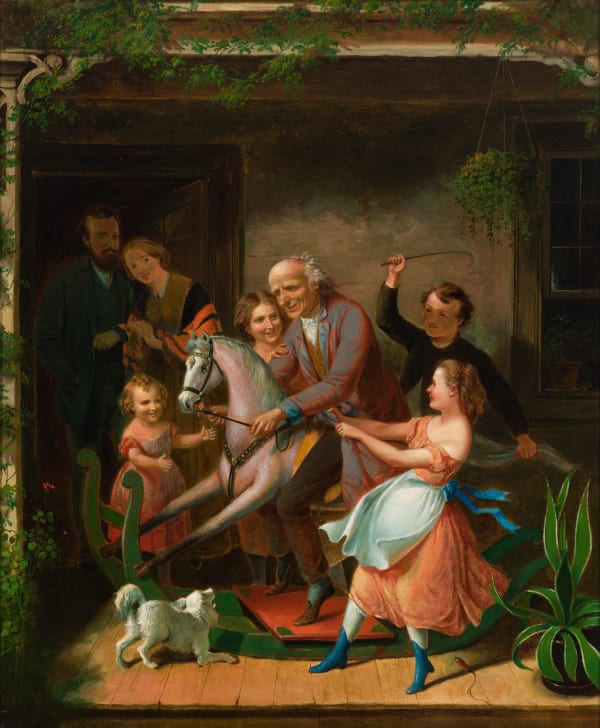In the United States in the mid-1800s, artists such as George Caleb Bingham, William Sidney Mount, and Eastman Johnson increasingly found their subject matter in quotidian life around them. Like these artists, Tompkins [aka “Thompkins”] Harrison Matteson also resisted the call of landscape painting and the dominant Hudson River School. Instead, he threw in his lot with the genre painters of the mid-nineteenth century. In addition to his excelling at depicting everyday life, Matteson also attracted popular acclaim for his historical, patriotic, and religious paintings. His moralizing and sentimental scenes appealed to Americans around the time of the Civil War and were widely circulated in the United States through lithographic reproductions.
Matteson was born in Peterboro, NY in 1813 and named after NY Governor Daniel Tompkins (later U.S. vice-president from 1817-25). Because Matteson lived in a relatively remote area of upstate New York, he was basically self-taught. As a young man, he worked as an itinerant portrait painter in the western New York towns that were booming with the opening of the Erie Canal. Unlike many U.S. artists of his time, he never studied in Paris.
He did move to New York City in the early 1830s, however, where he received the encouragement of John Trumbull, the famous history painter of the U.S. Revolution. For a while, Matteson lived in Sherburne, NY, a small village in Chenango County. But in 1841, Matteson returned to New York City, opened a studio, and switched from portraiture to patriotic subjects. Between 1841 and 1845, he took some classes at the National Academy of Design and was elected an associate in 1848. His painting, “Spirit of ’76,” was well-reviewed and bought by the Art Union. He followed with numerous depictions of the American Revolution and colonial America. Matteson’s reverence for George Washington helped inflate and spread Washington’s reputation in the nineteenth century. His work entitled “George Washington at Valley Forge” sold at Christie’s in 2009 for $315,000.
Matteson also loved to paint the Pilgrims, whether on the Mayflower, living in Massachusetts, or embroiled in witchcraft trials. The painter Elihu Vedder wrote that Matteson liked to be called “the pilgrim painter” and even wore an unusual steeple-crowned hat and short mantle as an homage to the Pilgrims. Matteson’s historical paintings, although a touch bombastic to the modern eye, were much in demand in the mid-nineteenth century. H.S. Sadd, a well-known illustrator, turned many of these paintings into historical engravings.
In 1850, Matteson returned to Sherburne and bought two homes next to each other, converting one into an art studio. There he brought up a large family and spent the rest of his life. In Sherburne, he was active in local affairs and served in various public offices such as a member of the NY state legislature (elected as a Democrat in 1855), president of the Chenango Agricultural society, president of the school board, and foreman of the fire department. He also conducted drawing classes and attracted some talented students such as Elihu Vedder.
In 1840s, lithographic reproduction became an important means of disseminating art and national news in the United States. Matteson was quick to grasp the opportunity and his work featured prominently in these new illustrated publications. He painted many sentimental domestic scenes that were then engraved for women's magazines.
Matteson loved the countryside at Sherburne and his paintings took on the anti-urban bias so common in mid-nineteenth century art. Looking at his canvases, the viewer would have no idea of the industrialization and urbanization sweeping the country. Nor did he take U.S. westward expansion as a subject. Instead, his genre scenes often were based on rural life, for example “Sugaring Off” (1845); “Justice’s Court in the Backwoods” (1850); “Hop Picking” (1862); and scenes out of novels by James Fenimore Cooper and Washington Irving.
“Playing with Grandfather” (1869), a late work, shows Matteson at his most amiable. In this large oil, he has democratized and sentimentalized the famous painting “Henri IV Playing with His Children” by Jean Auguste Dominique Ingres and made it relevant to an American audience.
In Book of the Artists [1867], art critic Henry Tuckerman issued a damning synopsis of Matteson’s work that retains a ring of truth: “The national and rustic subjects drawn by this pioneer genre painter [Matteson], indicate the average taste of the people, and suggest what themes, executed with greater finish and more subtle elaboration, would most successfully illustrate this branch of art among us.” However, if Matteson was not on the level of Bingham or Mount, his genre scenes contained a naïve sincerity much appreciated by people of his time, and they continue to charm in the twenty-first century.

